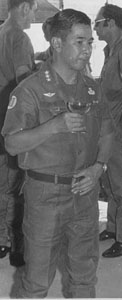

General Minh was a relative newcomer to the game of political appointments, though he had been in the military since 1950 when he served as an airborne officer under the French. After backing the wrong side in an unsuccessful coup against then-President Ngo Dinh Diem in November 1960, Minh was banished to An Giang Province in the Delta where he served as province chief until after Diem's death in November 1963. A year later he became deputy commander of the 21st ARVN Division, still in the Medong Delta, where the insurgency had reached dangerous proportions. In 1965 Minh was promoted to brigadier general and given command of the division. In early 1966 the American deputy senior division adviser noted that the successes of the 21st ARVN Division were "due primarily to the leadeship and skill of the division CG (commanding general) Major General Nguyen Van Minh. This division is an aggressive fighting force, and extremely well-led..." General Minh was also instrumental in developing an effective air mobile capability for the division within eight months of taking command.
But as a corps commander, Minh was out of his league. He was an able and energetic administrator, not a fighter, and the responsibility of handling both the military situation in the field and the political games in the capital proved to be a crushing weight. To make matters worse, Minh was also responsible for the security of Saigon, which, although it fell inside III Corps, was considered a separate administrative zone.
Minh's uneasiness in the highest level of command and his limited sense of strategy quickly became apparent. During a battle between the Airborne Division and the 141st VNA Regiment in December 1971 an entire enemy battalion was all but wiped out. General Minh was elated and he believed the enemy threat to the border area to be over. On 26 December he ordered all South Vietnamese troops out of Cambodia and released the Airborne Division to the general reserve. Other South Vietnamese units were redistributed to their original positions throughout III Corps, leaving a buffer zone of rangers to act as sensors for any further enemy movement. Without lifting a finger the North Vietnamese were able to remain in place inside Cambodia, secure in the knowledge that the South Vietnamese would not pursue them. Beginning in early 1972 the North Vietnamese were allowed to prepare unmolested for the coming offensive.
(pp 374-377)
Dale Andrade
Trial By Fire
1995